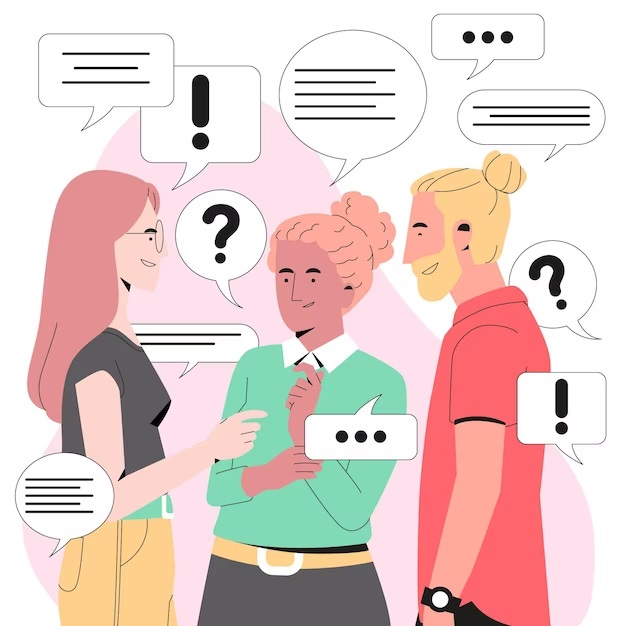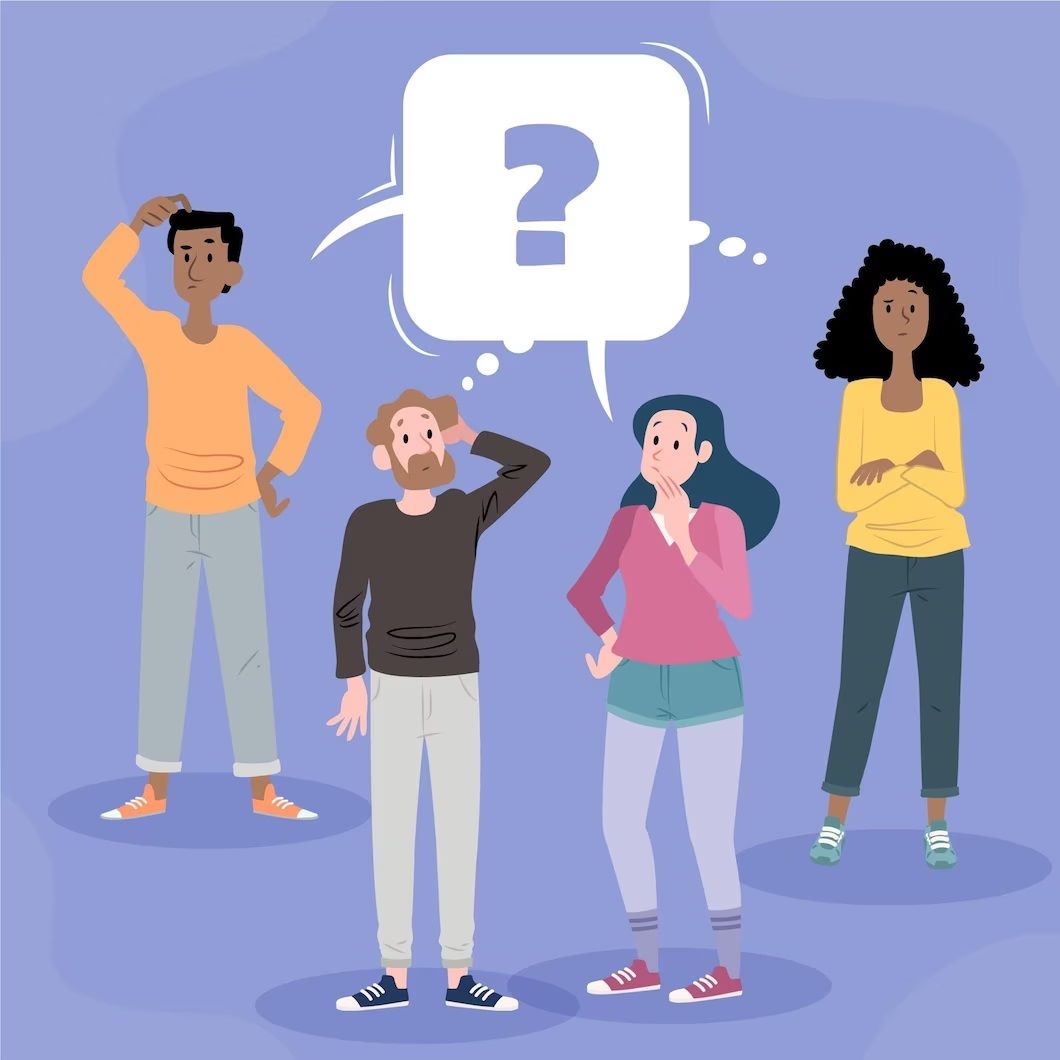Asking Open-Ended Questions to Encourage Sharing
Asking Open-Ended Questions to Encourage Sharing
Asking open-ended questions is an effective tool for encouraging sharing in any setting, whether it's a business meeting, a classroom, or a family dinner. Open-ended questions allow for more thoughtful and detailed responses, creating a space for individuals to express their personal opinions, experiences, and insights. In contrast, closed-ended questions limit responses to a yes or no answer, offering little opportunity for meaningful conversation or reflection. When we ask open-ended questions, we signal that we are interested in the other person's thoughts and feelings, and we create a space for authentic communication and connection.
Open-ended questions can be used in a variety of contexts, such as interviews, team meetings, and brainstorming sessions. They can help us gain a deeper understanding of others' perspectives, build empathy, and encourage exploration and creativity. For example, in a team meeting, asking open-ended questions can lead to new ideas and solutions that may not have been considered before. In a family setting, open-ended questions can help create a more open and supportive environment, where everyone feels heard and valued.
However, it's important to remember that asking open-ended questions requires active listening and genuine curiosity. It's not enough to simply ask the question and wait for a response - we need to be present and engaged in the conversation, actively listening to the other person's words and body language. We also need to be aware of our own biases and assumptions, and approach each conversation with an open mind. By asking open-ended questions with intention and sincerity, we can create deeper connections, foster mutual understanding, and promote personal and professional growth.
The Benefits of Using Open-Ended Questions
Open-ended questions provide valuable insights and encourage deeper conversation than closed-ended questions. When you ask open-ended questions, you allow the respondent to provide a detailed response without limiting their answer to a pre-determined set of options. As a result, open-ended questions are ideal for conversations that require a more comprehensive understanding of the topic. Their flexibility makes them particularly useful in complex situations where there isn't a straightforward answer.
Moreover, open-ended questions enable you to learn more about the respondent's point of view. At times, it can be easy to assume that someone else shares our opinions or views on a particular issue. However, open-ended questions help uncover potential biases, misunderstandings or gaps in knowledge without being confrontational. The information gathered from these types of questions can then be used to help build bridges of understanding and promote collaboration, even among people with different perspectives or priorities.
Lastly, open-ended questions promote creativity, reflection and critical thinking. When you ask someone to provide an open-ended response, you allow them to be creative with their answer. This allows them to explore possibilities, share ideas and experiences that may otherwise have been left unsaid. Through this creative process, respondents may also discover new insights or perspectives they had not previously considered. As a result, open-ended questions have a unique ability to foster curiosity and help people to think more deeply about the issues they face.
The Challenges of Constructing Open-Ended Questions
Constructing open-ended questions can be a challenging and time-consuming task. Unlike closed-ended questions, which limit the possible answers, open-ended questions allow for a broader range of responses. However, this flexibility in responses can also make it difficult to word the question in a way that will elicit the desired information. Often, open-ended questions require more thought and effort to generate than their closed-ended counterparts because they need to be carefully crafted to avoid ambiguity and confusion. It is crucial to ask clear and concise questions to ensure that the respondents know what you mean and can provide useful answers.
Another challenge of constructing open-ended questions is that they can be prone to bias. Researchers must be careful not to word the question in a way that predisposes the respondent to give a particular answer. For example, if a question asks about the positive aspects of a specific product, the respondents may feel compelled to provide responses that showcase the product's benefits, even if they do not believe in them. Additionally, framing a question negatively may lead to negative responses. Researchers must strive to eliminate bias to ensure that the responses are reliable and accurate.
Finally, collecting and analyzing data from open-ended questions can be daunting. Unlike closed-ended questions that provide responses in a predetermined format, open-ended questions generate unstructured, qualitative data that can be difficult to classify and measure. Analyzing this type of data requires a skilled and objective approach to identify themes, patterns, and meanings in the responses. Additionally, because open-ended questions generate longer and more complex answers, the process of analyzing them can be time-consuming and resource-intensive. Researchers must carefully weigh the benefits and limitations of using open-ended questions to ensure that they align with their research objectives.
Types of Open-Ended Questions to Ask
Open-ended questions are a valuable part of any conversation. Unlike closed-ended questions, which can only be answered with a yes or no or a single piece of information, open-ended questions encourage more thoughtful and detailed responses. There are many different types of open-ended questions, each focusing on a different area of discussion. The first type is exploratory questions. These questions are designed to delve deeper into a topic, asking about underlying causes or motivations, personal experiences, or perspectives. These questions can be useful in facilitating a deeper understanding of a topic, as well as in encouraging critical thinking and discussion.
The second type of open-ended question is discovery questions. These questions focus on exploring new ideas or possibilities, often with the intent of uncovering something previously unknown or unexplored. Discovery questions can help to spark creativity and innovation, as well as to generate new insights and perspectives. They are particularly useful in brainstorming or problem-solving sessions, where a fresh take on a challenge or issue can make all the difference.
The third type of open-ended question is strategic questions. These questions are focused on identifying specific goals or outcomes, and exploring how to achieve them. Strategic questions can be very useful in a variety of contexts, from business planning to personal development. By asking strategic questions, individuals or teams can develop a clearer understanding of what they want to achieve, and create a plan of action to get there. When used effectively, these questions can be a powerful tool for achieving success and making progress towards desired outcomes.
Ways to Frame Open-Ended Questions
Open-ended questions can be an effective way to engage your audience in conversation and get them to think deeply about a topic. These questions are designed to encourage people to explore their thoughts and feelings on a subject, rather than simply giving a yes or no answer. To frame an open-ended question, it is important to start with a general topic and then gradually narrow it down into more specific questions that will prompt thoughtful responses from your audience. This can be done by using words like 'why' or 'how' to prompt more introspection on a particular topic.
One of the key benefits of open-ended questions is that they encourage dialogue between people. When you ask an open-ended question, you create a space for people to share their thoughts and opinions in a more meaningful way. This can be particularly valuable in group settings, where different perspectives can lead to greater understanding and critical thinking. In order to make the most of open-ended questions, it's important to actively listen to the answers that are given, and to be curious and open-minded about what people have to say.
Another important aspect of framing open-ended questions is to be aware of your audience and the context in which you are asking the questions. The way you phrase your questions can have a big impact on the responses you receive, so it's important to tailor your questions to the specific audience you are addressing. For example, if you are working in a business context, you might ask questions about how people feel about a particular strategy, whereas if you are working in a school setting, you might ask open-ended questions about how students feel about a new curriculum. By being mindful of your audience and context, you can ensure that you are framing questions in a way that is most likely to elicit thoughtful and meaningful responses.
Developing Open-Ended Questions With a Goal in Mind
Open-ended questions can be a powerful tool for learning and growth, but they must be developed with a specific goal in mind. When crafting open-ended questions, it is essential to consider what information or insights you hope to gain from the answers. This goal should guide the structure and wording of the question, ensuring that respondents are more likely to provide useful and relevant information.
Another key consideration when developing open-ended questions is to focus on the respondent's perspective. It can be tempting to craft questions that reflect your own assumptions or biases, but this approach can limit the usefulness of the answers. Instead, strive to create questions that invite the respondent to share their own experiences and insights. This may require some research and empathy on your part to understand the respondent's mindset and to develop questions that resonate with them.
Finally, it is important to test your open-ended questions before using them in a larger survey or study. This can help identify any ambiguities or confusions in the wording, as well as potential issues with the structure of the question. When testing questions, consider recruiting a small group of respondents who fit the target demographic and using surveys or interviews to assess their understanding and comfort with the question. This feedback can be invaluable in refining your questions and ensuring that they effectively achieve your research goals.
Asking Questions to Stimulate Further Discussion
Asking questions is a powerful tool for fostering deeper discussions in any setting. Whether it's a classroom, a boardroom or a family gathering, asking challenging and thought-provoking questions can lead to a more productive conversation. By asking questions, you encourage others to brainstorm, analyze and reflect on their own ideas, which in turn can lead to fresh perspectives and solutions. A good question can also help create a more inclusive environment, where everyone has an opportunity to participate and share their knowledge and experiences.
One effective technique for stimulating further discussion is to ask open-ended questions. These are questions that require more than a simple yes or no answer and typically start with words like 'why,' 'how' or 'what.' Open-ended questions invite deeper exploration and reflection and can lead to more nuanced and multi-layered conversations. Another strategy is to ask follow-up questions that build on what has been said. This can help to clarify meaning, explore potential ramifications and prompt further ideas and insights. Finally, don't be afraid to ask challenging or controversial questions. These types of questions can open up new perspectives and perspectives and can be particularly useful in breaking down assumptions and biases.
In conclusion, asking questions is an invaluable tool for stimulating further discussion, generating new ideas and driving decision-making. Whether you're in a business meeting, a classroom or a family gathering, thoughtful and strategic questioning can help you to facilitate more productive conversations and deepen your understanding of the world around you. So don't be afraid to ask questions, and remember that the most effective questions are open-ended, follow-up and challenging. With these tools in your arsenal, you'll be well-equipped to foster more engaging and informative discussions wherever you go.
Strategies to Ask Open-Ended Questions
Effective communication is essential for building successful relationships in both personal and professional settings. Open-ended questions play a crucial role in fostering such communication, as they promote thoughtful and detailed answers. Unlike closed-ended questions, which can be answered with a simple yes or no, open-ended questions allow respondents to express their thoughts and feelings fully. In this regard, open-ended questions are a valuable tool for gathering information and establishing rapport.
However, asking open-ended questions requires more than simply adding a question mark to the end of a statement. To ask effective open-ended questions, one must first understand the purpose of the question and the listener's perspective. Effective open-ended questions require careful consideration of the respondent's interests, concerns, and experiences. This information should then be used to create questions that encourage thoughtful and honest responses.
Another useful strategy for asking open-ended questions is to start questions with phrases such as 'why' or 'how'. These words prompt more detailed answers and lead to deeper conversations. Additionally, asking clarifying questions can help to ensure that responses are clear and accurate. Using open-ended questions effectively takes practice, but the effort is well worth it. By asking open-ended questions, you can gain a greater understanding of others and build stronger relationships.
Examples of Open-Ended Questions
Open-ended questions are those that rely on unrestrained responses from the interviewee or responder. Typically, they require more thought and lengthy explanations, providing greater insight into the responder's experiences, opinions, beliefs, and feelings. Open-ended questions can be used in various settings, including interviews, surveys, and conversations. Unlike closed-ended questions that restrict the responder's choice to predetermined answers, open-ended questions provide an opportunity for the responder to provide unique responses.
The benefits of using open-ended questions in interviews and surveys are numerous. They help the interviewer or researcher understand the respondent's point of view more deeply, increasing the validity and reliability of the research or study. Open-ended questions also allow the respondent to express their thoughts and experiences in their own words, giving the interviewer a glimpse into their world. Furthermore, open-ended questions can elicit information that may have been overlooked or ignored had closed-ended questions been used exclusively.
However, there are some challenges to using open-ended questions. For example, they can be time-consuming and require patience from both the interviewer and the respondent. Additionally, interpreting the responses can be more complicated as the answers may be more varied and open to interpretation. Nonetheless, these difficulties pale in comparison to the benefits of using open-ended questions in interviews and surveys. With proper training and preparation, open-ended questioning can be a powerful tool in gaining a deeper understanding of an individual's experiences, perspectives, and beliefs.
Exploring Alternatives With Open-Ended Questions
Open-ended questions are a powerful tool in exploring alternatives. They offer room for creativity, provoke thought and encourage a deeper level of engagement. When used effectively, open-ended questions generate robust responses that can lead to innovative approaches or solutions. By asking open-ended questions, we create a space for free thinking, where people can tap into their imaginations and explore possibilities without hindrance.
Exploring alternatives is critical for success in our dynamic world. Change is the only constant, and those who embrace new ideas, perspectives and methods are the ones who thrive. Open-ended questions are particularly effective in this context as they allow for a diverse range of viewpoints to emerge. As a result, we can better understand the different needs, values, and priorities of stakeholders or communities. By doing so, we can develop creative alternatives that meet their specific needs, which in turn, will lead to more successful outcomes.
Open-ended questions can be used in a range of settings, from personal reflection to organizational planning. They are particularly useful in brainstorming sessions, strategic planning, product development, research, and group discussions. Open-ended questions often start with words like 'what if, 'how might', or 'tell me more about.' These questions encourage participants to think outside of the box, to reach beyond their current understanding and to explore alternatives that they may have never considered before.
Best Practices for Stimulating Conversation
One of the best practices for stimulating conversation is to ask open-ended questions that encourage participation. Instead of asking yes or no questions, try to ask questions that encourage people to share their experiences and opinions. By asking questions that tap into people’s interests and passions, you can create a more engaging and dynamic conversation. Don’t be afraid to dig deeper and ask follow-up questions to keep the conversation flowing.
Another best practice for stimulating conversation is to actively listen to others. This means paying attention to what others are saying without interrupting or interrupting in a respectful and attentive manner. By actively listening, you can show others that you value their input and opinions. This can help build trust and respect, making it easier to continue the conversation and create deeper connections with others.
Finally, try to create a comfortable and welcoming environment that encourages conversation. This can be as simple as offering drinks or snacks, playing appropriate background music, or arranging seating in a way that promotes interaction. When people feel comfortable and at ease, they are more likely to engage in conversation and contribute to the overall atmosphere. Ultimately, the key to stimulating conversation is to be genuinely interested in others, ask thoughtful questions, and create a welcoming environment where people feel comfortable sharing their experiences and perspectives.
Benefits of Using Open-Ended Questions For Remote Teams
Open-ended questions are an essential tool when it comes to communicating effectively with remote teams. These questions allow team members to express themselves fully and honestly, facilitating a two-way conversation that results in better problem-solving and decision-making. With open-ended questions, team members can explore different possibilities and perspectives, leading to a more comprehensive understanding of the situation at hand.
One of the primary benefits of using open-ended questions is that they give team members the opportunity to articulate their thoughts and feelings in their own words. This can be especially important for remote teams, who may not have the benefit of non-verbal cues or face-to-face interaction. By allowing everyone to express themselves, team members are better able to build trust and establish meaningful relationships with each other.
Finally, open-ended questions help to ensure that everyone is on the same page when it comes to project goals and objectives. By encouraging a deeper level of engagement, these questions can help to clarify any misunderstandings or misconceptions and ensure that everyone is working towards the same outcomes. This can be especially important for remote teams, where the lack of physical proximity can sometimes lead to a disconnect between team members.
Choosing the Right Open-Ended Questions for Different Situations
Open-ended questions are an essential tool for anyone looking to gather information and deepen their understanding of a certain topic. These questions allow individuals to express their thoughts, opinions, and experiences more freely, providing more comprehensive responses that can be used for a wide range of purposes. However, knowing what type of open-ended question to ask in different situations is critical to eliciting the most valuable responses. For instance, when conducting market research, asking open-ended questions that allow customers to provide detailed feedback on their experiences with a product or service can provide insights that might not be available with closed questions. Similarly, in a job interview, asking open-ended questions about a candidate's experience and qualifications can help recruiters to gain a better understanding of their personality and suitability for the role.
Another situation where open-ended questions are invaluable is in counseling and therapy sessions. In this context, open-ended questions can be used to help the individual explore their emotions, needs, and beliefs more deeply, encouraging them to reflect in a way that can help bring about behavioral change. Rather than simply asking 'yes' or 'no' questions, a counselor might ask, 'How did that make you feel?' or 'Can you tell me more about what's going on for you right now?' These questions can act as prompts to encourage the individual to delve deeper into their thoughts and feelings and can be particularly useful when dealing with sensitive or complex issues.
Lastly, open-ended questions can be beneficial in group settings such as team meetings or brainstorming sessions. By asking questions such as 'What are your thoughts on this idea?' or 'What might be some potential solutions to this problem?', individuals are free to express their ideas without fear of judgment or the need to conform to a specific format. Open-ended questions can lead to more creative and innovative ideas, as individuals are encouraged to think differently and to consider multiple perspectives. Additionally, these questions can help to build trust and foster a more collaborative environment, which can have a positive impact on team performance and cohesion.



